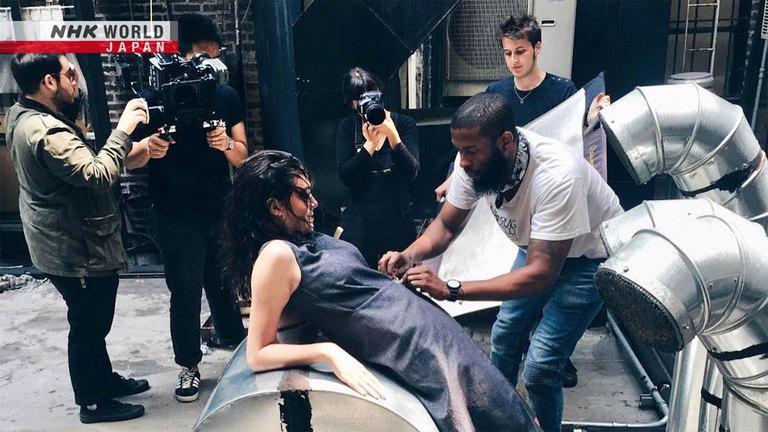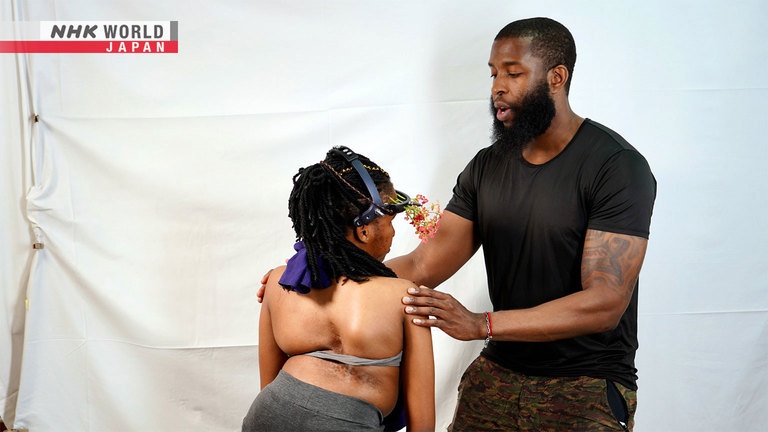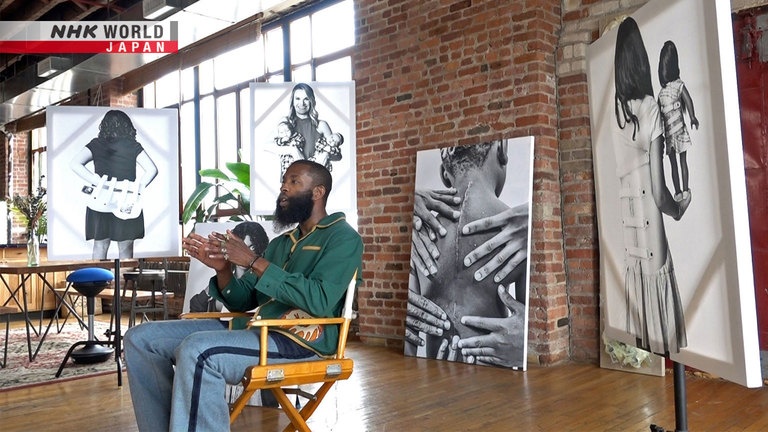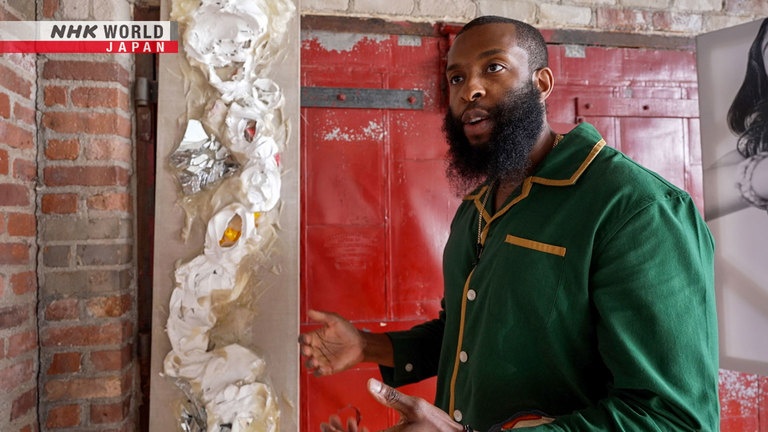Reviving Spirits of Ailing Backs: Marcus John / Founder of Back to Healing
Marcus John founded "Back to Healing," a non-profit that empowers people living with ailing backs called scoliosis. He is a director who expands support by mixing fashion, art, medicine and technology.




Transcript
Direct Talk
Today's guest is Marcus John.
He is the founder and president
of the non-profit organization
"Back to Healing."
John, has been active in the fashion world.
He got involved in the non-profit
when he learned that a close friend
was suffering from a certain disease.
The condition is called scoliosis.
It causes the spine to curve
to the right or left.
John started a movement to help people with
this back problem through fashion and art.
The one encounter with his friend
motivated him to eventually
lead an organization,
influencing many others
globally to join his cause.
You know, it's
"Back to Healing,"
and just the healing hands
around the scar from scoliosis.
And now his vision has crossed borders
and has aided children
in impoverished countries.
Marcus John, tells us more about
appealing to the entire globe
by integrating fashion,
art, medicine, and technology.
Reviving Spirits of Ailing Backs
A few close friends of mine
actually are impacted by scoliosis
and with myself being a creative director
as well as a wardrobe stylist
in the fashion industry.
I just felt that it was best for me
to use my skill sets
to help support them in regards to
what they go through
mentally, physically and whatnot to create
awareness and things of that nature so.
How can I make her happy?
How can I empower her?
How can I make her feel beautiful?
How can I?
So just asking these types of questions.
And that's when I just basically
created a concept in the beginning of
a beauty and empowerment campaign
for anyone that is affected by scoliosis.
Just by walking on this street,
a patient with scoliosis may be found.
It's estimated that about two to three people
out of 100 have the symptom.
That's about 160 million people worldwide.
So scoliosis is actually
the most common spinal condition
out of all these spinal conditions.
And also it's
essentially it is a
sideways curvature of the spine
that measures greater than
10 degrees to the left or to the right,
facing the examiner
and also to what it's a really
big on a person's mental health
as 40% of individuals
affected by this condition
actually suffer from suicidal thoughts.
It's also considered a hidden condition
because many people actually
hide it through loose clothing.
Through, with females,
this is growing their hair out intentionally
so they can hide the curvature of the back
or the scar of it they had surgery.
Marcus John was an
up-and-coming creative director.
And suddenly he faced a turning point in 2016.
It was an event that changed
his outlook on life and art.
So my background is in fashion as a
creative director and wardrobe stylist,
my work has been on the cover of
Harper's Bazaar, Editorial,
Vogue and GQ, Esquire
and a close friend of mine,
she really just loves my work
in the way that I style individuals.
And she was attending her first gala,
which was also a huge gala
which was "VH1 Save the Music,"
and she asked me to style her for it.
I just had her come to set of my photoshoot
so we could get fitted for her.
And when she came,
she'd seen the clothing rack from a distance
and she was just extremely excited about it.
And, as she gets closer to the rack,
she looks basically at the dress
from the bottom up
and she's like feeling the materials.
She's just touching it and really loving it.
But then when she gets the top of the dress,
she sees that it's like, shoulder-less.
And she's like,
"Okay, I really love this one."
And all of a sudden it was,
"Let's see the next one."
So, then she gets to the next one,
starts from the bottom up again.
Starts feeling the materials
sees the length of it,
and now she sees that
it has a deep V in the back
and she's just like,
"Oh, I really love this one as well,
but let's just get to the next one."
and then the next one
as she sees that has a high neck,
but then its backless.
So she's on to the next one.
She was just like overwhelmed,
I believed, at the time.
And she, then said,
"Hey, Marcus," like,
"you mind if I speak to you in the back."
And I was like, "Yeah,"
like, "no problem at all."
But in my head, also at the same time,
it's like did I say something wrong
or I said something offensive,
I was just a little confused.
So
I start walking to the back and
And, you know, she said
"Hey, Marcus, like,
you know, I'm like one of your biggest fans.
that's the only reason also one of the reasons
why I asked you to style me for the gala."
and she was like,
"You know, but"
she says the word, "but,"
a teardrop just falls from her eye.
And I, now, instantly started thinking again,
like I must have said something wrong.
And she says,
"You know, but I suffer from scoliosis."
And, also at the time, for myself,
I was unaware of how scoliosis
impacted the human body.
So then I told her, I was like,
"Listen, I don't mean to sound ignorant
in any kind of way,
but I'm just not sure
how that affects the human body,
what it looks like, or anything."
So she then showed me her spine,
and it's literally like "S,"
when,
someone who doesn't have scoliosis their spin
is supposed to be more so straight up.
And when I see it, though,
I mean, so I also viewed it
as a beautiful uniqueness versus,
like a deformity, things like that.
And from there
I just more so wanted to create
an empowerment campaign for anyone
that was dealing with anything like.
Marcus John was born in 1988 in Boston.
He is of Jamaican descent.
His natural taste of fashion
may have been inherited from his grandfather.
He was the first black suit maker
for Brooks Brothers in Massachusetts.
Just remember, he's always in a suit.
He was always like having a matching hat
with sometimes his shoes or his socks or
he had like these cool square frames
at the time and,
you know, bearded up as well.
He was definitely a very fashionable man.
You know, my siblings, my mother,
father, everyone is just very so fashionable.
So even when we have
just get togethers for holidays,
whatever the case is,
everyone always just
comes dressed to impress.
So it's fun.
Born in Boston and then
went and moved to Atlanta, Georgia.
And then right after college,
I went, moved to New York City.
A lot of people think
I went to fashion school.
I never took one fashion class.
Yeah, I think it was,
some people just have a natural talent
and I would like to think
I have a natural fashion talent.
Just having a strong sense of confidence
and a sense of style that I feel.
Marcus John saw it as his mission
to help people with scoliosis.
He recruited a group of friends,
and in 2016, founded the
non-profit organization, "Back to Healing."
The name of the NPO
perfectly fits its mission.
Yeah, and it just worked out perfectly.
So it's Back to Healing Incorporated
as the full name.
Play along the words of mental health
as well as scoliosis.
Essentially our mission is
to improve the quality of life
of individuals affected by scoliosis,
through mental health awareness,
education, empowerment, and advocacy.
And I just honestly just want to give a voice
to individuals impacted by this condition.
In 2017, "Back to Healing" debuted
its exhibition in New York Fashion Week.
That was my first ever exhibition
and I collectively
was able to garner a lot of support from
very incredible individuals having scoliosis.
All of them have very inspiring stories.
Once again, I'm really big on diversity,
and so I wanted to show all different ages,
different races, different genders.
Some who were surgically treated,
some who are nonsurgical,
and it was just an incredible night.
So one of their metrics of success was
if we can get at least 50 people
to attend the opening night party to this,
that would be incredible.
That first night, we had over 410 people.
And an incredible thing as,
well for me, at least,
we don't show the participants their photos,
so they just come say a month or two prior,
get the photographs taken.
And then from there
they don't see the images again
until the opening night when they attend
and that at the opening night event
they attend with their loved ones,
their families, their spouses, whatever.
And I just remember seeing just
the participants seeing their photos
for the first time.
Many of them were crying,
just due to an overwhelming emotion
of just happiness or proudness
or just feeling like they're,
like they're seen, like they're heard.
Because once again,
they don't really speak about this condition.
Even if someone asks them about it,
sometimes they deny it,
or once again, wear their hair,
or just loose clothing.
So no one knows.
But this time was more so like,
this is me, this is who I am,
this is my story.
And I'm ready to come out to the world
to show individuals who are affected,
or individuals who also
may be affected by this condition
and in hopes to inspire them,
in hopes to motivate them,
to share their stories as well.
It was absolutely incredible night.
From that night alone,
I saw that this is something that
I continue, I want to continue doing.
Marcus John found new inspiration,
seeing beauty in scoliosis.
He collaborated with
some of the world's finest artists,
and that chemistry led to a new work of art.
The woman in the picture is Mary Lisa Idol.
She also has scoliosis.
You know, Marcus was really
celebrating the beauty of Scoliosis.
If so, how can I be a part of this?
I want to be involved.
I've never even heard of
anything like this before.
And I just actually had had twins.
I have twin girls and
I was on maternity leave
and I was I think I was three,
four months postpartum.
And he texted me and said
"I know you just had babies,
but we'd love to,
you know, photograph you and the girls."
And it was amazing.
You know, I covered up my scars for years.
10 years ago, I would have said,
no, I got to cover my scar.
I need something that,
where you can't see, you can't see.
And I don't want people to question me
and ask me questions.
But now I'm proud.
It's really helped me kind of take that
off my shoulders and feel empowered.
In recent years, Marcus John has been
trying to expand "Back to Healing"
and make the non-profit more meaningful
by reaching out to new supporters
and raising more funds.
He has held exhibitions in Los Angeles,
Miami, among many other locations.
We generate revenue
by selling artwork itself.
Where if you,
if anyone's familiar with Stryker,
which is one of the biggest
medical device companies.
If you ever go to their headquarters
in the U.S., at least, which is in Virginia,
our artwork decorates
their entire auditorium.
We also sell our artwork themselves.
Photographs and other means are
through partnerships and sponsors.
So they, you know,
do donations to us as well.
So there are different ways
that we can definitely get crafty
and that we definitely raise funds.
I would say, you know
so that ones that we have annually
is definitely our exhibitions that we do
and our newly incorporated ones
are our mission trips.
So one is a lot for mental health
and representation, which is our exhibitions.
Another one is really just providing children
free surgeries from all around the world,
living in impoverished areas
who could never afford it on their own.
Those are very special to me because
when we have a mission trip, whatnot,
they're able to provide us with the implants
as well as equipment for our team of surgeons
to actually travel to these countries.
So the surgeons that we work with,
they donate their time
and we fly out to,
the first one was actually in Brazil
under our Back to Healing umbrella
that was last November.
And we partnered with
an incredible hospital over there,
Medtronic as well as Stryker.
And basically, they donated implants to us.
And these implants were,
they equate to almost, not even almost,
they equate over $2.5 million
in in-kind donations
and once again,
we're able to provide free surgeries
to these children who can never afford it.
We spoke with one of the physicians
who is working with Marcus John.
You know, Marcus approaches scoliosis
treatment from a different perspective.
You know, he's an artist
with a strong passion for,
taking care of patients with scoliosis.
So that's been the unique thing about Marcus,
where even though he's not a physician,
he's still managed to find ways he can
support those patients and also support
us as physicians to get the treatment
that we were trying to get to these patients
and also expand us
outside of our comfort zone.
I'm based in Rochester, New York,
but we work on traveling around the world to
provide scoliosis scans, scoliosis education.
John left us with his favorite words.
"If You Believe, You Shall Achieve."
I feel like with strong belief,
with anything that you set yourself
to do or strive to do,
I feel like anything is possible
with just the right dedication,
ambition, faith in everything.
And this is just
speaking from personal experience.
And so I strongly believe in this motto here.